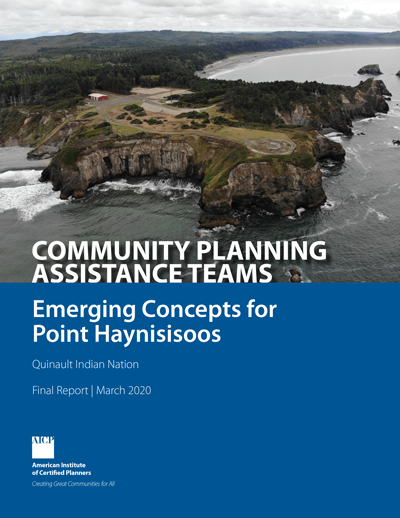Emerging Concepts for Point Haynisisoos
Community Planning Assistance Team

The Quinault Indian Nation (QIN), through its Community Development and Planning department, requested a CPAT to help engage the community and assess the potential of Point Haynisisoos (pronounced Hun’is’shu). Point Haynisisoos is a rocky promontory on the Pacific Ocean coastline of the Quinault Indian Reservation, located on the southwestern corner of the Olympic Peninsula in Washington.
The Point holds special significance to the Quinault for a variety of reasons. Most recently, the Point took on new significance as the host site for a regional intertribal event known as the Paddle, a canoe journey undertaken by tribes of Oregon, Washington, and British Columbia to a rotating set of host reservations. The QIN envisions the Point and surrounding area as its permanent site for hosting the gathering into the future, but is also interested in planning for the area beyond just the Paddle.
The team’s report provides three concepts for Point Haynisisoos that emerged from their engagement with the community and existing data and information. The concepts explore broad themes with specific ideas around access, cultural and environmental stewardship, and economic development. In addition, the report discusses potential next steps, including financing.
Meet the Team

Team Leader
Joseph Kunkel
-

Team Member
Nathaniel Corum
Nathaniel Corum is an architect, planner, and educator serving as Design Director with Sustainable Native Communities Collaborative. Following leadership roles with Indigenous Community Enterprises, Red Feather, and Architecture for Humanity, Corum and the SNCC team now collaborate with MASS Design Group on tribal community initiatives in North America. As a former Fulbright Scholar, Senior Energy and Climate Partnership of the Americas Fellow, and Rose Architectural Fellow, he has pursued research and practice in culturally responsive design with over a dozen tribal community partners. Author of Building a Straw Bale House from Princeton Architectural Press, Corum's work includes showcasing exemplary native-to-place architecture through documentary film production, publications and the implementation of master plans, housing initiatives, community facilities, and ecological designs. He has helped to connect over 500 students to real-world, public-interest design workshops and projects. Corum's design work and process has been widely published and featured in international exhibitions. He holds a Master of Architecture from the University of Texas at Austin and an undergraduate Design Synthesis degree from Stanford University. -

Team Member
Tom Hampson
Tom Hampson began his career in planning and community economic development on the Umatilla Indian Reservation in 1973 where he and Michael J. Farrow created the Tribal Development Office, a fully integrated land use planning and community economic development arm of the Tribe. He was a founding member of the United Indian Planners Association. After developing businesses for the Tribe, he owned businesses of his own, ran a small business development center for Blue Mountain Community College in Pendleton, a small business incubator in “the hood” of Portland, and has helped Native nonprofit and for-profit organizations run better or run away ever since. Hampson did the foundational development work for the Columbia River Intertribal Fish Commission, Wallowa Band Homeland Project, Crow’s Shadow Institute of the Arts, and wrote and co-produced the multi-media exhibits for Tamastslikt Culture Institute for the Confederated Tribes of Umatilla, among many other projects. In December 2012 he retired after 12 years as executive director of ONABEN, a Native American Business Network. He is the principal author of ONABEN’s Indianpreneurship® Series — a story-based “how to” manual on starting and operating a family enterprise in Indian Country. At ONABEN he managed a two-year organizational development project for 10 Native CDFI’s which included the Taala Fund of Quinault Indian Nation. -

Team Member
John Koepke
John Koepke has over 35 years of professional experience in both private practice and academia. Along with his full-time responsibilities as a professor in the department of landscape architecture at the University of Minnesota, he is a principal in the firm Urban Ecosystems. Because of his Ojibwe heritage, Koepke has always had a significant interest in both Native American cultures and environmental science. This has led him to conduct landscape-based research on ancient Native American sites and work with tribal and other communities in pursuing teaching and design opportunities that focus on cultural interpretation, environmental education, ecological restoration, and reclamation. He currently teaches graduate and undergraduate level courses that focus on integrating ecological principles with artistic design thinking. Along with teaching studios he leads courses in construction technology and graphic representation. -

Team Member
John "J.D." Tovey, III, AICP
J.D. Tovey is the director of planning for the Confederated Tribes of the Umatilla Indian Reservation. Tovey holds a bachelor of landscape architecture from the University of Idaho and a master of urban planning from the University of Washington. He is a PhD candidate in urban design and planning at the University of Washington with a research focus on traditional ecological knowledge, resilience, and professional practice centered on the Columbia River basin tribes. Tovey is also an APA Oregon Chapter board member.
Details
Table of Contents
The Purpose of the CPAT Program
Executive Summary
Introduction and Background
CPAT Process
The Quinault
Point Haynisisoos
The Paddle
Existing Conditions on the Point
Recommendations
Emerging Concepts for the Point
Concept I: Gateway
Concept II: Sacred Place
Concept III: At Arm’s Length
Implementation
Financing
Next Steps
Appendices
Appendix A: Community Visioning Activity Notes
Appendix B: Nugguam News Story of CPAT Visit
Appendix C: Picture Gallery
Appendix D: Meet the Team


